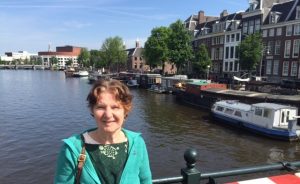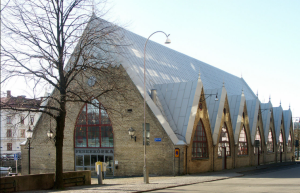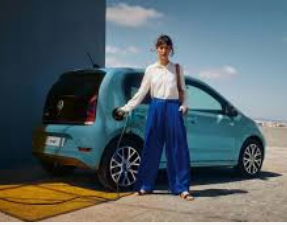Are People Free in a Social Welfare State?
by Alexandra Hopkins
In the summer of 2016, my husband Kim and I vacationed in three cities in northern Europe. In addition to catching a break, we wanted to learn about life in a social welfare state. We wanted a bit of real-life experience with the “Nordic Model,” as these economies are called.
My husband, Kim, and I are flying over the Atlantic Ocean right now, on our way home to Los Angeles from Northern Europe—Amsterdam, Copenhagen, and Gothenburg, Sweden. We used our summer vacation to taste a few social welfare states. They tasted good!

Author on bridge near our rented houseboat in Amsterdam, June 2016. [Photo credit: Kim Hopkins]
On our visit, we talked with a lot of ordinary people–Uber drivers, our hosts in Sweden, tour guides, and others. Then, I did further research online.
Are we talking social welfare state or socialism? A quick review—Americans often define countries as socialist if the industries, businesses, and real estate are owned and managed by the central government. And the government is usually a dictatorship—a dictatorship “of the people,” of course! In the U.S. the term “socialism” is sometimes used interchangeably with “communism.”
The Nordic countries call themselves “socialist,” but they define it differently. They are what Americans would call “social welfare states” or “social democracies.” Importantly, the majority of their industries, businesses, and real estate are privately owned in a capitalist economic system. And they are not dictatorships at all; they are democracies.
So, how do they differ from the U.S.? Their unions are stronger, their businesses are more heavily regulated, their taxes are higher, and their tax monies create stronger social safety nets.
Taxes provide their citizens with free or inexpensive:
• Education from preschool on up through the highest levels of university degrees,
• Healthcare,
• Assisted-living care for the elderly, and
• Retirement benefits.
In addition, unemployment benefits, vacations, and parental leave for caring for newborns are much more generous than in the U.S. Workweeks are shorter. There’s also an emphasis on gender equality so that women have as much opportunity in their jobs as men.
The out-there Danish approach to higher education. The Danish approach to higher education is particularly noteworthy. Not only is university free for Danes, but also students who do not live at home are paid stipends which cover basic room and board. The stipend can be extended for earning a Masters or PhD. Students who attend trade schools also receive stipends.

Copenhagen [Photo credit: Public Domain, Wikipedia]
The young woman told me with pride about the Danish system. She was on a one-year maternity leave while continuing to receive a stipend. It took me a few moments to understand what she was on maternity leave from—her job as a student! Her husband, also a university student, received a stipend and worked part-time. The average Danish college student graduates with zero debt.1
In contrast, the average American college student of 2015 graduated with $35,000 in student loans.2 For the average couple graduating from college, that’s starting out in life with a debt of $70,000. I don’t want to even think about those unfortunate souls at the high-end of the student debt spectrum.
In all three cities during our visit, it was university graduation time. Groups of young people wearing school caps biked past us and filled boats on the many waterways or sat together in cafes. They drank, sang songs, and celebrated in a non-cynical happy way that I don’t see among college students in the U.S.
Is it true about the Danes being happy? My husband and I independently ranked the happiness vibes that we experienced in each country and, then, compared notes. Our rankings were identical. From least to most happy: U.S., Sweden, Netherlands, Denmark. When I later looked it up, I found that our rankings agreed with those reported in the U.N.’s annual World Happiness Report for the three-year period, 2013-15:
U.S. 7.104
Sweden 7.291
Netherlands 7.339
Denmark 7.526 (highest in the world)
These rankings are on a scale of 0 to 10, so rankings at above 7 are towards the high end. These differences in the U.N. report appear tiny; but Kim and I experienced these differences vividly.
Of course, I’m sure that there are plenty of unhappy people in the cities that we visited. We were sensing the zeitgeist in a brief visit, which could, no doubt, hide a thousand tribulations and sorrows.
And what about Denmark and Sweden’s long dark and dismal winters—what does that do to their suicide rates? After all, Iceland, also a Nordic Model country, is known to have an extremely high suicide rate. I checked. The Nordic Model countries, including Iceland, all have suicide rates lower than ours in the U.S. In the case of Denmark and the Netherlands, the rates are 25% lower.3
How does it feel to have so much government in your life? The level of political freedom in these countries seemed as high as in the U.S., and in some ways, higher.
The people we spoke with felt quite free. They did not feel that their electoral system is corrupted by money. And their incarceration rates are considerably lower than ours. In Amsterdam, prostitution is legal and marijuana virtually legal.
The citizens of Amsterdam, in particular, have a long history of tolerance of people who do their own thing. “Doing your own thing” hit a high point in the 1960’s Dutch counterculture movement. This movement spread to Denmark and inspired hippies in Copenhagen to “liberate” an abandoned military base in the city.
The hippies built little homes and gardens on the base, and even now, run it as a large commune. With 900 residents, “Freetown Christiania” is a major tourist attraction. I should mention that this commune, with its litter, graffiti, and marijuana sales, is far from any kind of utopia that I would want to live in. And it generates plenty of controversy among the Danes.
Freedom House, a non-partisan, non-profit organization rates countries each year by their level of civil liberties and human rights. It compares freedom in each country against the rights listed in the U.N. Declaration of Human Rights. The rating of 0 is worst and 100 is best. Here are the 2016 ratings4:
U.S. 90
Denmark 98
Netherlands 99
Sweden 100
In contrast, North Korea rated a score of 3. I assumed that this was the lowest until I saw that, on a scale of 0 to 100, Syria was rated a minus 1 !
So, yes, freedom is thriving in Northern Europe. Contrary to the beliefs of some Americans, freedom is actually more vigorous in these social welfare states than in the U.S. This is not to say that there is unbridled freedom in these countries. Some people we met complained about the restrictions of bureaucracy just as we do in the U.S. For example, we, being Quakers, visited a Quaker congregation in Amsterdam. They owned a building that they had hoped to remodel. But they held back because they said city regulations would make doing so a nightmare.
It reminded me of the challenges our Quaker congregation in Pasadena, California, recently experienced. Our building is lovely and over 100 years old. The City has designated it as historic. We’re honored but, at the same time, constrained by detailed regulations regarding renovations. When we rebuilt the foundation for earthquake safety, we were required to retain the antique brickwork on the façade of the foundation. We kept the historic aesthetics, but it complicated the project.
Taxes out-the-roof. People in welfare states have made the choice to provide everyone with certain basic services. This takes money. Here’s a comparison of average 2015 taxes as a percentage of household income5:
U.S. 40 %
Netherlands 52 %
Sweden 57%
Denmark 55%
These are the percentages that taxes represent of all expenditures during the year (GDP). While almost everyone we talked with on our visit thought their taxes were high, they also felt that they got good value for their money. This makes sense. They aren’t laying out large amounts for medical expenses, college tuition, or retirement savings. We Americans have those expenses on top of what we pay in taxes.
From our observations of how people in Northern Europe live, they are spending less on personal possessions than we do in the U.S.—fewer and smaller cars, smaller homes, and less gadgetry and luxury goods. This was apparent when we stayed at a condominium of our architect friend who lives in Gothenburg, Sweden. The entire interior of the condo was painted white. No pictures hung on the walls. No doo-dads lined the shelves. The emptiness of the condo would have delighted a Buddhist monk.
An AirBnB apartment that we rented in Copenhagen was smaller and had more stuff in it. But there was no dishwasher and the fridge was similar in size to the ones we have in hotel rooms in the U.S. Danes deal with small fridges by shopping frequently.

Feskekorka (“Fish Church”) in Gothenburg, Sweden. Not a church at all, it’s a fish market designed with simple Scandinavian grace. [Photo credit: David Castor, Public Domain, Wikipedia]
In the Northern European countries that we visited, the average number of rooms is 1.8 to 1.9 rooms per person. In the U.S., it’s 2.4 rooms.6 As this is per person, a home for a family of four would have significantly more rooms in the U.S. than in Northern Europe. No question that in the U.S., families buy considerably more private space than in Northern Europe. In addition, families in the U.S., on average, buy considerably more stuff than in Denmark.7
But, it’s hard to make a valid comparison because in a welfare state, family income doesn’t have to stretch to pay for healthcare, college tuition, and retirement savings. The Swedish couple whom we stayed with, in their 70’s, were all but retired but had never saved for retirement. They are able to live quite comfortably with a pension and the Swedish version of Social Security. Travel is their main entertainment.

The Volkswagen Up! was the most popular car sold in Denmark in 2015.

The Ford F-Series was the most popular “car” sold in the U.S. in 2015.
You can see it with your own eyes. If you have not visited a social welfare state, you might consider doing so. When we weren’t peppering Uber drivers with questions, we enjoyed the beauty of their historic cities and their broad emerald green landscapes. As Southern Californians, we were delighted to find that in some places, it actually rains more than a few times a year. Of course, many Northern Europeans think that raining every other day isn’t exactly idyllic. Our Airbnb host in Amsterdam has laid plans to move to sunny Santa Barbara.
Postscript… As we took our first steps back in the U.S., walking through L.A. International Airport, I saw Americans with new eyes. I enjoyed the individualistic way that we dress—so many unique and odd styles. Whatever the realities of political freedom, we’re louder and we’re freer in our motions than are many Europeans. And the Uber driver who took us from the airport to our home was unlike any we had met in Europe. I didn’t get a chance to interview him–unasked, he told us his entire life story.
We Americans certainly offer something special and valuable to our world. But other countries have things to offer too. The trick is to open our eyes, not buy into myths, and take the best from what each country has to offer.
Sources:
1 “This Country Is Literally Paying Students to Go to College,” by Zeeshan Aleem, Policy.mic, February 10, 2015. https://mic.com/articles/110302/this-country-is-literally-paying-students-to-go-to-college#.cnmdBbW2A
2 “Congratulations, Class of 2015. You’re the Most Indebted Ever (For Now).” by Jeffrey Sparshott, Wall Street Journal, May 8, 2015. http://blogs.wsj.com/economics/2015/05/08/congratulations-class-of-2015-youre-the-most-indebted-ever-for-now/
3 OECD Data “Suicide Rates, Table” https://data.oecd.org/healthstat/suicide-rates.htm
4 Freedom House “Freedom in the World 2016, Table of Country Scores” https://freedomhouse.org/report/freedom-world-2016/table-scores
5 Individual Income Tax Rates Table https://home.kpmg/xx/en/home/services/tax/tax-tools-and-resources/tax-rates-online/individual-income-tax-rates-table.html
6 OECD Better Life Index “Housing in Detail by Country” http://www.oecdbetterlifeindex.org/topics/housing/
7 Nationmaster https://www.nationmaster.com/country-info/compare/Denmark/United-States/Cost-of-living